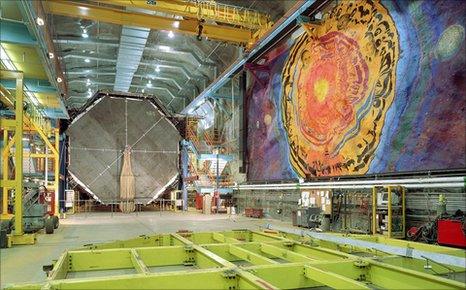Neutrino 'ghost particle' sized up by astronomers
- Published

The study used data on the distribution of galaxies
Scientists have made their most accurate measurement yet of the mass of a mysterious neutrino particle.
Neutrinos are sometimes known as "ghost particles" because they interact so weakly with other forms of matter.
Previous experiments had shown that neutrinos have a mass, but it was so tiny that it was very hard to measure.
Using data from the largest ever survey of galaxies, researchers put the mass of a neutrino at no greater than 0.28 electron volts.
This is less than a billionth of the mass of a single hydrogen atom, the scientists say.
Their nickname is fitting: a neutrino is capable of passing through a light-year (about six trillion miles) of lead without hitting a single atom.
The results are to be published in the journal Physical Review Letters and will be presented at the Weizmann UK conference at University College London (UCL) this week.
"Back in 2002, we put an upper limit on the neutrino mass of 1.8 electron volts. So this is an improvement by a factor of six," said co-author Professor Ofer Lahav, from UCL.
"It is remarkable that the distribution of galaxies on huge scales can tell us about the mass of the tiny neutrinos."
The work resulted from the PhD thesis of UCL scientist Shaun Thomas, working with Professor Lahav and Dr Filipe Abdalla.
Scientists used the largest ever 3D map of galaxies in the Universe, based on data gathered by the Sloan Digital Sky Survey.
Ocean waves
They were able to determine a new upper limit for the neutrino particle by analysing the distribution of galaxies across the Universe.
The matter in the cosmos naturally forms into "clumps" of galaxy groups and clusters.
As neutrinos are extremely light they move across the Universe at great speeds. This has the effect of smoothing out the natural "clumpiness" of matter, the research team says.
Professor Lahav likens this to ocean waves smoothing out a pile of sand on a beach.
By analysing the extent to which this "smoothing-out" of galaxies has taken place, scientists were able to work out the upper limits of neutrino mass.
Professor Lahav believes neutrinos are a minor component of cold dark matter, the mysterious "stuff" which comprises some 25% of the Universe and more than 80% of matter in the Universe.
"The neutrino is squeezed into that slice [of the Universe] that is dark matter. But it probably accounts for less than one percent of that dark matter," he told BBC News.
The neutrino particle comes in three "flavours": muon, tau and electron. In a recent experiment, physicists caught a neutrino in the act of changing from one type to another.

The Minos experiment was set up to study neutrino oscillations
The finding by researchers on the Opera experiment in Italy provides a missing piece in the puzzle that has challenged scientists for decades.
In the 1960s, US scientist Ray Davis observed far fewer neutrinos arriving at the Earth from the Sun than models predicted. Either the models were wrong, or something was happening to the neutrinos on their way.
A possible solution to the puzzle was provided in 1969, when theorists suggested that chameleon-like oscillatory changes between different types of neutrinos could be responsible for the apparent deficit.
Several experiments have observed the disappearance of muon neutrinos, confirming the oscillation hypothesis.
But until the results from Opera, no observations of the appearance of a tau-neutrino in a pure muon-neutrino beam have been observed.
Another project, called Minos, recently reported results which point to a fundamental difference between neutrinos and their anti-matter counterparts, known as "anti-neutrinos".
In the experiment, a beam of muon anti-neutrinos was fired from the Fermilab particle accelerator in Chicago through the Earth to the Soudan underground lab in Minnesota.
They found a relatively large difference in the way neutrinos and anti-neutrinos oscillated between one type and another. This difference could not be explained by the established theory of particle physics, known as the Standard Model.